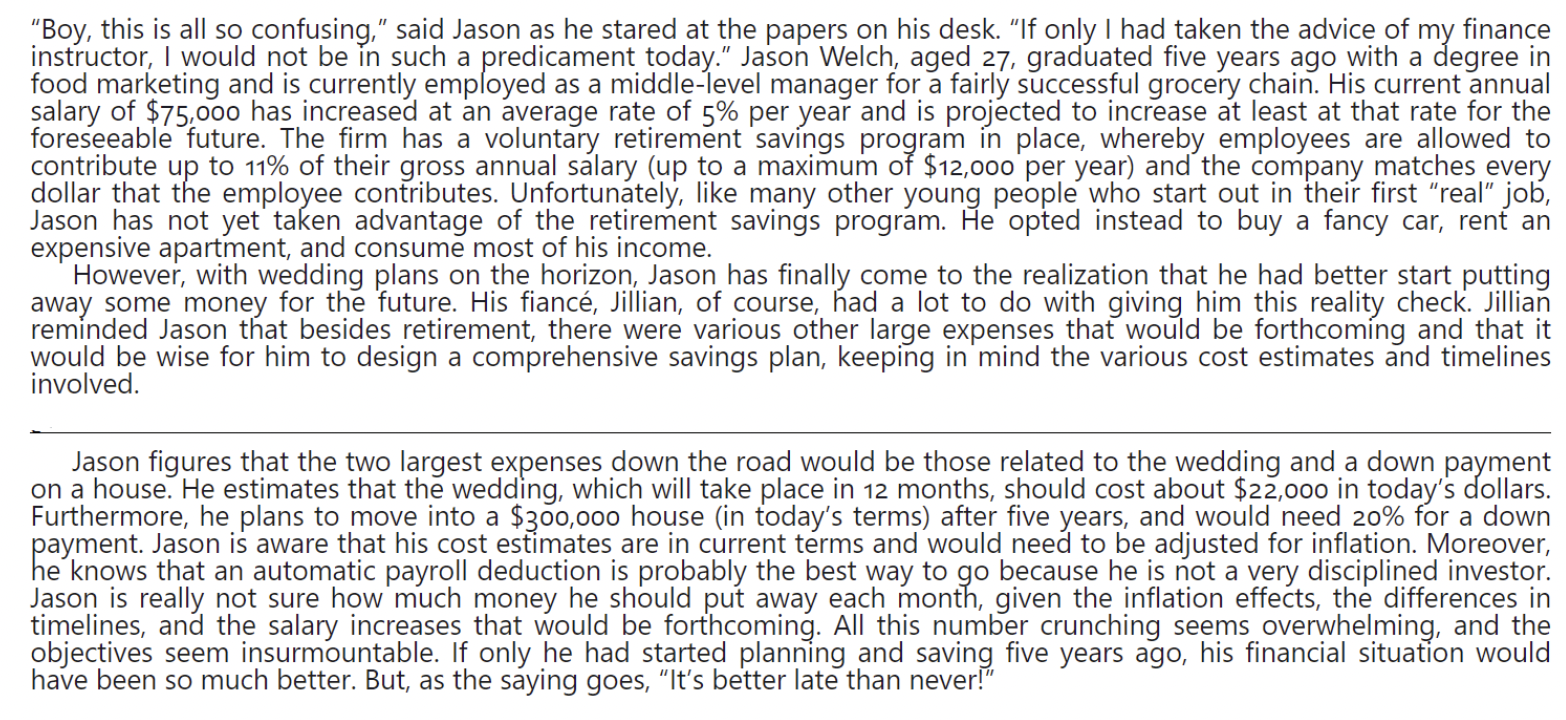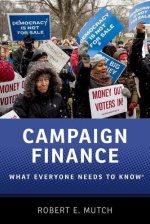Question
Had Jason taken advantage of the companys voluntary retirement plan up to the maximum, every year for the past five years, how much money would
 Had Jason taken advantage of the companys voluntary retirement plan up to the maximum, every year for the past five years, how much money would he currently have accumulated in his retirement account, assuming monthly deposits and a nominal rate of return of 7%? How much more would his investment value have been had he opted for a higher risk alternative (i.e. 100% in common stocks), which was expected to yield an average annual return of 12%?
Had Jason taken advantage of the companys voluntary retirement plan up to the maximum, every year for the past five years, how much money would he currently have accumulated in his retirement account, assuming monthly deposits and a nominal rate of return of 7%? How much more would his investment value have been had he opted for a higher risk alternative (i.e. 100% in common stocks), which was expected to yield an average annual return of 12%?
How much would Jason have to save each month, starting from the end of the next month, in order to accumulate enough money for his wedding expenses, assuming that his investment fund is expected to yield a rate of return of 7% per year?
"Boy, this is all so confusing," said Jason as he stared at the papers on his desk. "If only I had taken the advice of my finance instructor, I would not be in such a predicament today." Jason Welch, aged 27, graduated five years ago with a degree in food marketing and is currently employed as a middle-level manager for a fairly successful grocery chain. His current annual salary of $75,000 has increased at an average rate of 5% per year and is projected to increase at least at that rate for the foreseeable future. The firm has a voluntary retirement savings program in place, whereby employees are allowed to contribute up to 11% of their gross annual salary (up to a maximum of $12,000 per year) and the company matches every dollar that the employee contributes. Unfortunately, like many other young people who start out in their first "real" job, Jason has not yet taken advantage of the retirement savings program. He opted instead to buy a fancy car, rent an expensive apartment, and consume most of his income. However, with wedding plans on the horizon, Jason has finally come to the realization that he had better start putting away some money for the future. His fianc, Jillian, of course, had a lot to do with giving him this reality check. Jillian reminded Jason that besides retirement, there were various other large expenses that would be forthcoming and that it would be wise for him to design a comprehensive savings plan, keeping in mind the various cost estimates and timelines involved. Jason figures that the two largest expenses down the road would be those related to the wedding and a down payment on a house. He estimates that the wedding, which will take place in 12 months, should cost about $22,000 in today's dollars. Furthermore, he plans to move into a $300,000 house (in today's terms) after five years, and would need 20% for a down payment. Jason is aware that his cost estimates are in current terms and would need to be adjusted for inflation. Moreover, he knows that an automatic payroll deduction is probably the best way to go because he is not a very disciplined investor. Jason is really not sure how much money he should put away each month, given the inflation effects, the differences in timelines, and the salary increases that would be forthcoming. All this number crunching seems overwhelming, and the objectives seem insurmountable. If only he had started planning and saving five years ago, his financial situation would have been so much better. But, as the saying goes, "It's better late than never!" "Boy, this is all so confusing," said Jason as he stared at the papers on his desk. "If only I had taken the advice of my finance instructor, I would not be in such a predicament today." Jason Welch, aged 27, graduated five years ago with a degree in food marketing and is currently employed as a middle-level manager for a fairly successful grocery chain. His current annual salary of $75,000 has increased at an average rate of 5% per year and is projected to increase at least at that rate for the foreseeable future. The firm has a voluntary retirement savings program in place, whereby employees are allowed to contribute up to 11% of their gross annual salary (up to a maximum of $12,000 per year) and the company matches every dollar that the employee contributes. Unfortunately, like many other young people who start out in their first "real" job, Jason has not yet taken advantage of the retirement savings program. He opted instead to buy a fancy car, rent an expensive apartment, and consume most of his income. However, with wedding plans on the horizon, Jason has finally come to the realization that he had better start putting away some money for the future. His fianc, Jillian, of course, had a lot to do with giving him this reality check. Jillian reminded Jason that besides retirement, there were various other large expenses that would be forthcoming and that it would be wise for him to design a comprehensive savings plan, keeping in mind the various cost estimates and timelines involved. Jason figures that the two largest expenses down the road would be those related to the wedding and a down payment on a house. He estimates that the wedding, which will take place in 12 months, should cost about $22,000 in today's dollars. Furthermore, he plans to move into a $300,000 house (in today's terms) after five years, and would need 20% for a down payment. Jason is aware that his cost estimates are in current terms and would need to be adjusted for inflation. Moreover, he knows that an automatic payroll deduction is probably the best way to go because he is not a very disciplined investor. Jason is really not sure how much money he should put away each month, given the inflation effects, the differences in timelines, and the salary increases that would be forthcoming. All this number crunching seems overwhelming, and the objectives seem insurmountable. If only he had started planning and saving five years ago, his financial situation would have been so much better. But, as the saying goes, "It's better late than neverStep by Step Solution
There are 3 Steps involved in it
Step: 1

Get Instant Access to Expert-Tailored Solutions
See step-by-step solutions with expert insights and AI powered tools for academic success
Step: 2

Step: 3

Ace Your Homework with AI
Get the answers you need in no time with our AI-driven, step-by-step assistance
Get Started


